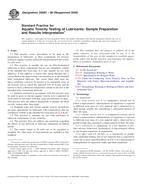Potrebujeme váš súhlas na využitie jednotlivých dát, aby sa vám okrem iného mohli ukazovať informácie týkajúce sa vašich záujmov. Súhlas udelíte kliknutím na tlačidlo „OK“.
ASTM D6081-98(2009)
Standard Practice for Aquatic Toxicity Testing of Lubricants: Sample Preparation and Results Interpretation
Automaticky preložený názov:
Štandardná prax pre vodné testovanie toxicity mazív : príprava vzoriek a interpretácia výsledkov
NORMA vydaná dňa 1.10.2009
Informácie o norme:
Označenie normy: ASTM D6081-98(2009)
Poznámka: NEPLATNÁ
Dátum vydania normy: 1.10.2009
Kód tovaru: NS-33691
Počet strán: 7
Približná hmotnosť: 21 g (0.05 libier)
Krajina: Americká technická norma
Kategória: Technické normy ASTM
Anotácia textu normy ASTM D6081-98(2009) :
Keywords:
aquatic toxicity, ecotoxicity, effect load, incident load, lethal load, lubricant, mechanical dispersion, water accommodated fraction (WAF), water soluble fraction (WSF), Aquatic toxicity, Lubricants, Toxicity/toxicology--petroleum products, Water analysis--petroleum products testing, Water soluble fraction (WSF), ICS Number Code 13.020.40 (Pollution, pollution control and conservation), 75.100 (Lubricants, industrial oils and related products)
Doplňujúce informácie
| Significance and Use | ||||||||
|
This practice gives techniques to use in the preparation of lubricants or lubricant components for acute or chronic aquatic toxicity tests. Most lubricants and lubricant components are difficult to evaluate in toxicity tests because they are mixtures of chemical compounds with varying and usually poor solubility in water. Lubricants or lubricant component mixtures should not be added directly to aquatic systems for toxicity testing because the details of the addition procedure will have a large effect on the results of the toxicity test. Use of the techniques described in this practice will produce well-characterized test systems that will lead to tests with meaningful and reproducible results. The toxicity of mixtures of poorly soluble components cannot be expressed in the usual terms of lethal concentration (or the similar terms of effect concentration or inhibition concentration) because the mixtures may not be completely soluble at treat levels that lead to toxic effects. The test material preparation techniques given in this practice lead to test results expressed in terms of loading rate, which is a practical and meaningful concept for expressing the toxicity of this type of material. One of the recommended methods of material preparation for lubricants or their components is the mechanical dispersion technique. This particular technique generates turbulence, and thus, it should not be used for poorly swimming organisms. |
||||||||
| 1. Scope | ||||||||
|
1.1 This practice covers procedures to be used in the preparation of lubricants or their components for toxicity testing in aquatic systems and in the interpretation of the results of such tests. 1.2 This practice is suitable for use on fully-formulated lubricants or their components that are not completely soluble at the intended test treat rates. It is also suitable for use with additives, if the additive is tested after being blended into a carrier fluid at the approximate concentration as in the intended fully formulated lubricant. The carrier fluid shall meet the above solubility criterion, be known to be minimally toxic in the toxicity test in which the material will be tested, and be known to have a chemical composition similar to the rest of the intended fully formulated lubricant. 1.3 Samples prepared in accordance with this practice may be used in acute or chronic aquatic toxicity tests conducted in fresh water or salt water with fish, large invertebrates, or algae. This practice does not address preparation of samples for plant toxicity testing other than algae. 1.4 Standard acute and chronic aquatic toxicity procedures are more appropriate for lubricants with compositions that are completely soluble at the intended test treat rates (1, 2, 3, 4, 5). 1.5 This practice is intended for use with lubricants or lubricant components of any volatility. 1.6 This practice does not address any questions regarding the effects of any lubricant or lubricant component on human health. 1.7 The values stated in SI units are to be regarded as standard. No other units of measurement are included in this standard. 1.8 This standard does not purport to address all of the safety concerns, if any, associated with its use. It is the responsibility of the user of this standard to establish appropriate safety and health practices and determine the applicability of regulatory limitations prior to use. |
||||||||
| 2. Referenced Documents | ||||||||
|
Odporúčame:
Aktualizácia technických noriem
Chcete mať istotu, že používate len platné technické normy?
Ponúkame Vám riešenie, ktoré Vám zaistí mesačný prehľad o aktuálnosti noriem, ktoré používate.
Chcete vedieť viac informácií ? Pozrite sa na túto stránku.




 Cookies
Cookies
